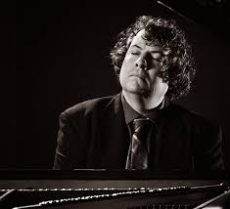
ALAN BRIADBENT TRIO FEATURING HARVIE S
Alan Broadbent and Harvie S. originally met when they were students at Berklee College of Music. After school, Alan left with the Woody Herman Band and that was the beginning of a brilliant career. Ending up in California, he was pianist for 25 years with Charlie Haden, and on top, of that winning Grammys for arranging.
Harvie S. stayed in Boston for a few years and was summoned to New York where he played and recorded with many of the Jazz greats
(Kenny Barron, Michael Brecker, John Scofield, Mike Stern, Eddie Henderson, Art Farmer and many more).
Alan Broadbent is most well-known for his arranging and piano playing with Natalie Cole, Barbara Streisand, Johnny Mandel, Charlie Haden’s Quartet West, Shirley Horn, Paul McCartney, and Dianna Krall to name just a few. He is twice Nominated for Grammys.
Harvie S. is one of the most popular bass players ever performing on over 400 albums, including 16 as a leader. His recordings and tours with Stan Getz, Pat Metheny, Chet Baker, Jim Hall, James Moody, Toots Thielemans, Shirley Horn, and many more are legendary.
Tickets: $45.00 ~ $50.00
More Posts: adventure,bandleader,bass,club,genius,instrumental,jazz,music,piano,preserving,travel

The Jazz Voyager
Making the roughly hour and half ride up the highway to come across the Verazzano~Narrows Bridge into the Big Apple after departing the City of Brotherly Love on a high note. This Jazz Voyager is heading uptown on the West Side to Columbus Circle for an evening of live jazz at Dizzy’s Club. This venue serves up a seasonal menu of delights for the palate, libations to please, and overlooks Central Park giving patrons the expansive vista views from their 5th floor location.
In residence from Wednesday to Saturday is master musician Herlin Riley and I will be in the company of this talented drummer. Hailing from NOLA, (New Orleans, Louisiana for those who don’t know) not only is he a bandleader in his own right but also holds the position in the Jazz At Lincoln Center Orchestra under the direction of Wynton Marsalis. Joining him on stage are saxophonist Stacy Dillard, pianist Tyler Bullock and bassist Liany Mateo.
Dizzy’s Club is located at Fredrick P. Rose Hall, Broadway at 60th Street, New York, NY 10019. For more information visit https://beta.jazz.org/dizzys.
More Posts: adventure,club,drums,genius,jazz,music,piano,preserving,travel

The Jazz Voyager
From Ann Arbor to the City of Brotherly Love is the travel plan for this Jazz Voyager as I head to Avenue of the Arts where culture and jazz lives. This trip is offering up a two-fer platter of entertainment at South Jazz Kitchen. Serving up elevated comfort food rooted in the food of the south for soul-satisfying dishes.
This Thursday I will be in the company of vocalist, songwriter, producer, musical theater actress and radio host Lori Williams who will be taking the stage. A layover is also going to have me returning to the club on Friday to give me the pleasure of seeing for the first time another amazing vocalist Sy Smith in person.
South Jazz Kitchen is located at 600 N. Broad Street Philadelphia, PA 19130. For more information visit southjazzkitchen.com.
More Posts: adventure,club,genius,jazz,music,piano,preserving,travel,vocal

Daily Dose Of Jazz…
Francesca Tanksley was born November 21, 1957 in Vincenza, Italy but grew up in Munich, Germany where she studied music from the age of seven. Moving to Boston, Massachusetts at 16, she studied piano and composition at Berklee College Of Music.
Two years later she returned to Munich. In 1980 she moved to New York City where she worked with Melba Liston until 1983, then she joined Billy Harper’s quintet with whom she toured extensively.
She has worked with Clifford Jordan, Cecil Payne, Bill Hardman and Erica Lindsay. She leads her own quintet and co-leads the Erica Lindsay/ Howard Johnson Quintet. As an educator she has been on the faculty of the New School, Berklee College. She has facilitated workshops and masterclasses at University of Southern California at Santa Cruz, Hampton University, Rensselaer Polytechnical Institute, Arizona State University, and Bard College.
Pianist Francesca Tanksley, who is a composer and educator, continues to perform and compose.
More Posts: composer,educator,history,instrumental,jazz,music,piano

JIM GAISOR
Jim Gasior is a titanic figure in Miami jazz. He has performed with Ricky Martin, Kelly Clarkson, Alih Jey, Chayanne, Little Richard, Michael Bolton, Jose Feliciano, Smokey Robinson, Benny Golson, Slide Hampton, Freddie Hubbard, Terell Stafford, Patti Austin, John Fedchock, Duffy Jackson, Jason Marsalis, Donald Harrison, Robin Eubanks, Jeremy Pelt, Jay Leonhart and the Jaco Pastorius Reunion Big Band. Jim holds a Bachelor’s degree in Studio Music and Jazz Performance, and a Master’s degree in Jazz Pedagogy – both from the University of Miami’s Frost School of Music, where he is in the final stages of his Doctorate in Jazz.
More Posts: adventure,bandleader,genius,hotel,instrumental,jazz,piano,preserving,travel



